#coracoid
Text
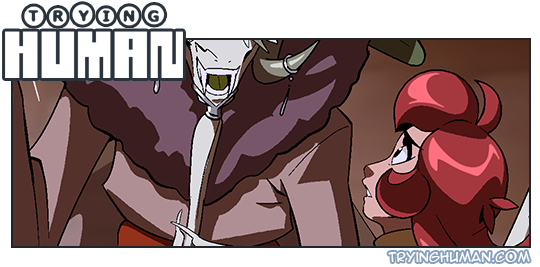
👽 Trying Human has updated! tryinghuman.com
📕 Buy the books here: tryinghuman.storenvy.com
🌳 Linktree: linktr.ee/tryinghuman
#trying human#tryinghuman#webcomic#graphicnovel#comic#update#alien#ufology#ufologycomic#reptoid#reptilianalien#rose#travis#magnus#gracelis#coracoid
42 notes
·
View notes
Text
guy who asked me what my favourite bone was as a joke but forreal thw scapula my best friend the scapula if you don't have a glenoid fossa DON'T talk to me
2 notes
·
View notes
Text
Salt

A wish to make a surprise visit to her Songbird only to find his nest in complete ruins. And even worse.. Gossamer finds Shamal with many feathers plucked and blood on the bronze of his scutes. Fresh.. The tears begin to downpour.
“Ohhh…!” Large droplets that look as if they were morning dew with how the Moth sobs, she finds herself unable to move and thus can only cradle her tearing face with all six hands. “Shamaaaal!”
“Heyyy, come on nooow my little dandelion puff..” A sweet chortle as he hops with absolute delicacy towards his Queen, Shamal prays that such bemused sounds do not appear insulting for truly laughter has always been his response to even troubles such as this. “Corrracoid is jusssst like this.. He comesss and he thrashsss out, it’s okaaay.”
And then he looms over the smaller Fae, wings expanding despite one of them clearly injured from a few harsh jabs. Gossamer is soaked in the salt of her own tears, looking like a spored pool of silver… glistening under the loom of Shamal as oddly shaped lights dangle in their broken connections and his eyes glow.. Protective, wishing to assure strength.
“B-But..” Hiccup. She reaches with her quivering and dripping limbs.. All fourup to grasp at his bitten and torn claw.. “W-who protects you..”
a wish that had been to simply surprise Shamal with affections now turns into something deeper in the Queen's heart.. soul.. I pray... it to be me, one day.. even if it were in another life.
1 note
·
View note
Text
gideon: i hate bones don't fucking talk to me about bones. bones are for nerds
somebody: hey this shoulder bone lying here is—
also gideon, immediately: that's the superior surface of the coracoid process of the left scapula, moron
#'i dont care about bones' why do you know so much about bones then.#gideon nav my favorite unreliable narrator#gideon the ninth#the locked tomb#neph.txt#neph tltposting
1K notes
·
View notes
Text
After referencing numerous diagrams, avian necropsy records, and my own prior knowledge of human musculoskeletal structure, I have devised speculative anatomical structure for Chozo.
We'll start small with my first attempts to properly chart basic skeletal structure from last year (seeing as how that's what I used as a jumping off point), then move on to the research-based stuff. I wanted to walk through the process of solving problems presented by the skeletal structure.


First we have a cursory look at the ribcage. Drafted June 7, 2023. Leaning into the more humanoid appearance.

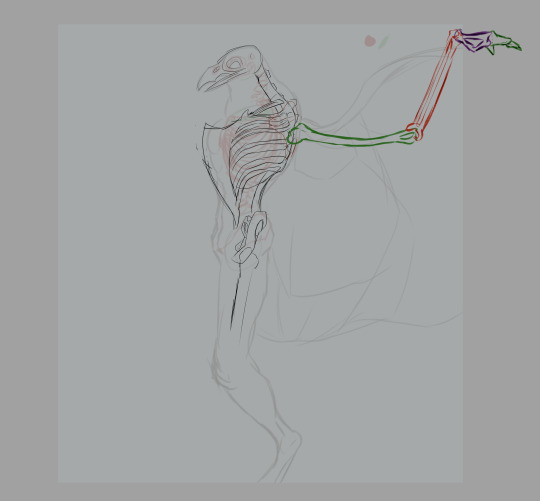
New addition, May 2024: a first shot at sussing out wing bones. These bones need to be much, much larger to accommodate the full breadth of the limb: this is just a rough outline. The skeleton also needs to bear muscles that are strong enough to carry the Chozo in flight, hence the new protrusion on the chest: a keel. Two variants of this new breast came out of this drawing session: one with a large keel that extends below the sternum and one with a normal keel.

Image credit: Wikipedia
Human ribcages have this ridge along the bottom that the last six ribs are attached to (noted in grey on the image above). We're not doing that with the Chozo ribcage.
The sternum is the structure in the middle, which the ribs are attached to. See those two bones attached to the top of each side of the sternum, stretching away from the center of the ribs and forming sort of a capital "T" silhouette? Those are the clavicles. When you're drawing any humanoid form, the clavicles are an excellent landmark (and as I've been taught, the first place you should start on anatomy after you've laid out your pose, armature, etc).
It's also part of why wings are so difficult to suss out on Chozo skeletons. In birds, a bone that consists of a fusion of the two clavicles is a crucial part of flight: the clavicle bridges the gap between the ribs and the arms, and for birds, the wings are their arms. That's problem number one: effectively consolidating two pairs of arms on one torso.
We have a few bones to add onto the human skeleton in order to make flight possible for Chozo. First, we'll assume all bones are hollow. This makes them lighter, demanding considerably less energy to lift them off the ground in the first place.
I've modified the sternum to add a keel, which the base flight muscles are going to be anchored to.

First pass at revising the skeletal structure. I made a few modifications unrelated to the wings. The pelvis is similar to that of a human, though a little wider to accommodate egg-laying. I may end up reworking the pelvis entirely to make it more bird-like, but I'm more interested in making those wings fit at the moment. Chozo have a human femur/patella, and avian lower legs.
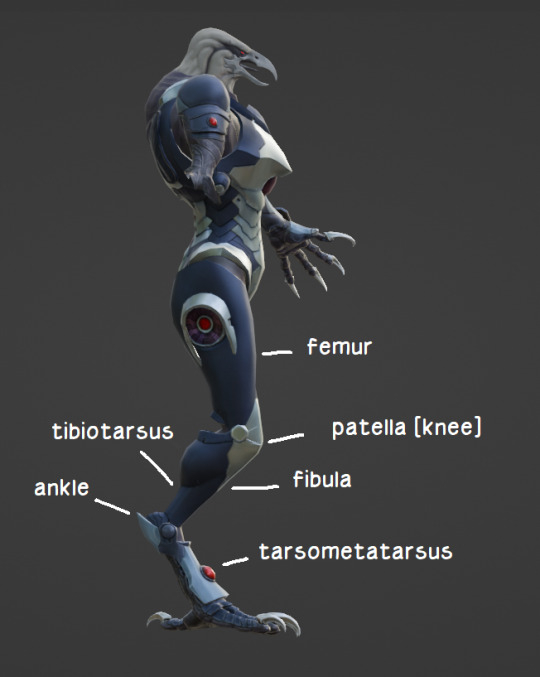
Here's a thing I slapped together in 3 minutes in January of last year to illustrate which bones are where for the layman. Onto different matters.
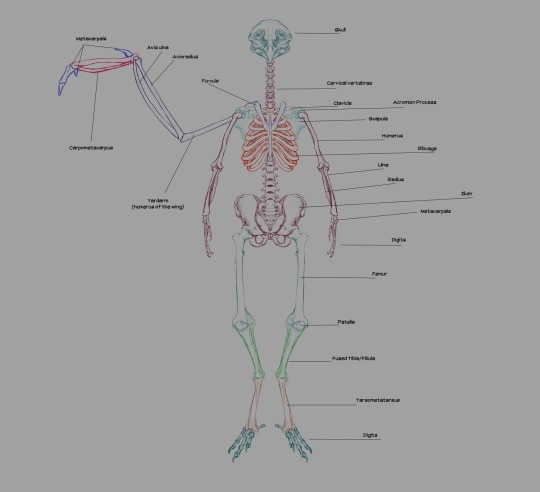
Skeleton, labeled.
Generally, the wings' humerus is attached to the scapulacoracoid, a bone attached to the keel that's sort of Y-shaped. That's how a real bird's shoulders are structured. Humans posses a scapula (shoulderblade), which has two protrusions: the acromion process and the coracoid process. The acromion process is where our humerus joins the shoulder. The coracoid process in humans is not exactly big enough nor ideally shaped to anchor flight muscles to.
At first, I had three ideas:
Invent a new bone attached to the keel that serves the function of the coracoid.
Modify the scapula to fit a new bone that anchors the flight muscles (the scapulacoracoid is analogous to the human scapula, after all).
Forego the keel and invent a bone on the spine that does the same thing.
To start, I added the furcula, a Y-shaped bone on the sternum, flanking the keel. Fun fact: not all birds have a furcula (better known as the "wishbone" in some parts of the world).

Real quick muscular structure layout sans flight muscles.

First pass at the flight muscles. Not the most accurate wing muscles in the world (neglected to depict the muscles near the tip of the wing, for one).
In this model of the musculature, a good deal of the flight muscles around the breast and torso are hidden by the pectoralis major, much like several non-flying human muscles.

Flesh applied over muscle.

Feathers applied over flesh.
That was my first attempt at constructing the Chozo skeleton. You'll notice the wing bone solution is inelegant. See, wings are analogous to arms. Their metacarpals are finger bones. In order to give Chozo both arms and wings, we'll need to deviate from both avian and human skeletal structures to make the pieces fit together.
I can't make the flight muscles stretch comfortably over the clavicle: that has the potential to impede motion in the arms. My first idea in the second round of flight bone shenanigans was to invent a second bone that fit between the spine and the scapula, like shoulder-bound plate tectonics (working name "scapula trellis"). I wasn't wholly confident that I could configure flight muscles in a logical manner even with this setup.
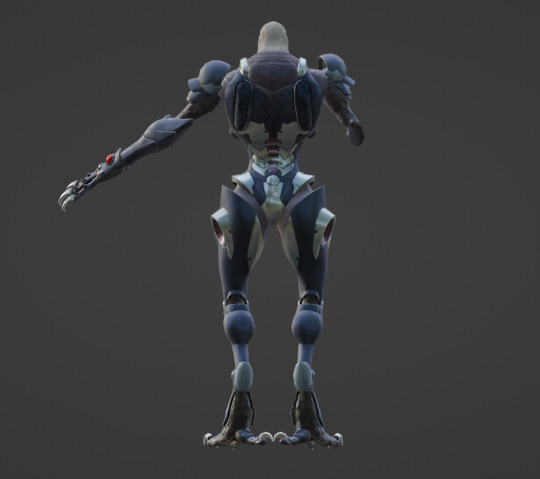
At one point I consulted Raven Beak's model. Note the patches on the back of the torso on the powersuit: that's where the wings emerge in phase 2. It looks like they're anchored to the scapula or an adjacent structure.
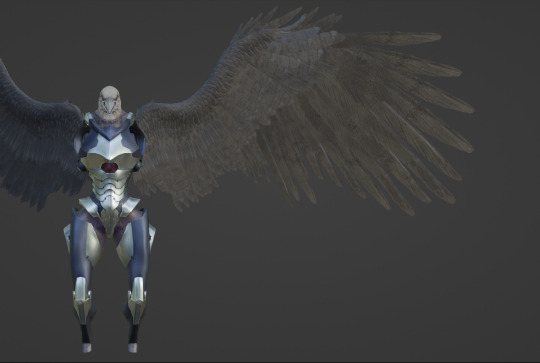
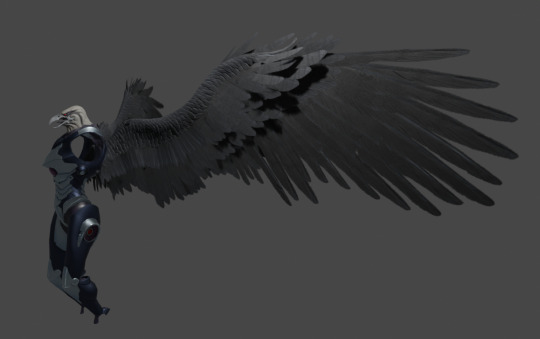
Barring the fact that his wings are absolutely ridiculous, I wasn't sure I could work with this. Gorgeous structures, but the feathers don't seem big enough to handle flight.
So I was left to brainstorm, and drafted up a few sketches for a second scapula to anchor the wings' shoulder joints to. I was more confident in this than I was the previous design, but I wanted to fish for ideas from other parts of nature.
Enter dinosaurs. Specifically, the Pteranodon with its shoulder girdle.

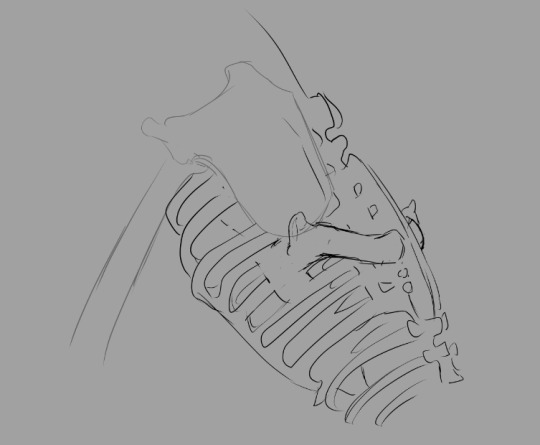
The addition of a shoulder girdle as an anchor for the yardarm (the term I'm using for the humerus of the wing, applicable only to creatures that have both wings and arms) seemed like a better solution. Positioning it below the scapula allows me to place the wings a little lower on the back, providing minimal interference between the two sets of limbs.
Whether we're rolling with the shoulder girdle or a second scapula, the intended result is the same: the wings have moved down on the back of the torso (personally, I'm digging the girdle, but the second scapula is on the table if anyone else wants to try their hand at this).
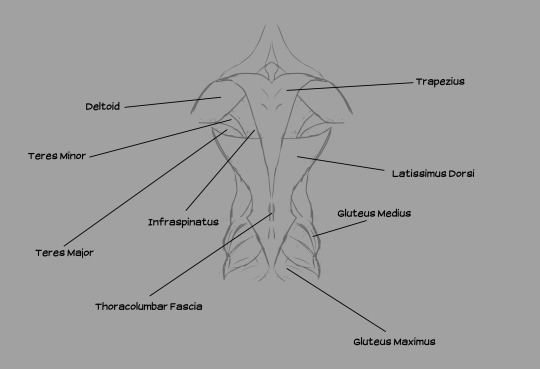
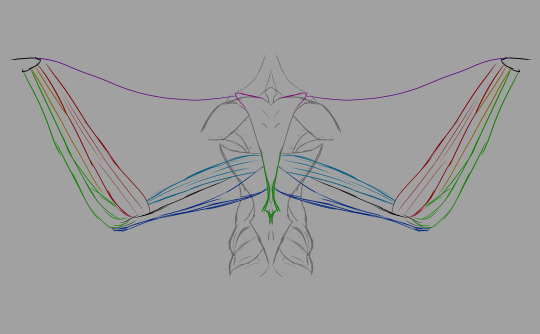

Muscles from the back, illustrated. Note the distance between the deltoid (shoulder muscle) and the wings. The shoulder girdle is situated in the lower-middle of the back of the ribcage.
A few notes: the acromioecstasia exists because the muscle that usually connects between the body and the patagialis longus on real birds is located on the pectoralis major. If I emulated that, we'd have flesh crossing over the deltoid to reach the front of the body, which would obstruct movement of the arms. We don't want that, so I moved that section of the wing to the back. We're compensating by adding additional musculature up front.
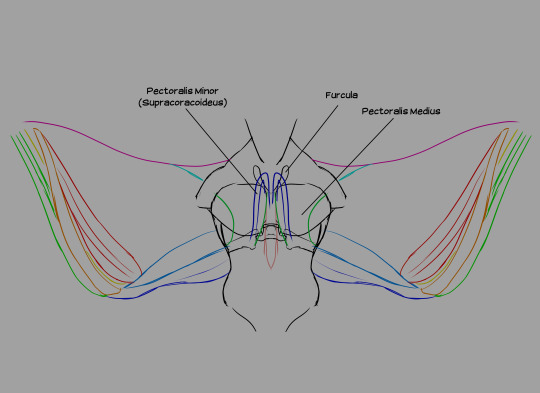
Wing muscles from the front. All three pectoral muscles are attached to the keel. The pectoralis medius is an extension of the pectoralis major, running beneath it and several other muscles. The pectoralis minor (also known as the supracoracoideus) lies beneath both the major and the medius. The pectoralis medius and major are responsible for the downstroke, while the supracoracoideus raises the wing between flaps.
Flight is very taxing on the individual. Power suit wearers actually have an easier time flying than non-wearers because the suit passively offsets the metabolic demands of flight with its own Energy.
It's important to note that these sizes are not necessarily "to scale". Chozo wings should actually be much bigger than my canvas permitted me to show. I had to keep increasing the size of the canvas on one of my files to accommodate a reasonable wingspan, but even that's not broad enough! I had to stop expanding the canvas for the sake of my CPU. If any muscles look too dinky or the scale seems off on some bones, that's why: I just needed to swiftly illustrate where things are.

A Chozo's total wingspan should at least be twice the individual's standing height. Any smaller and there's no lift.
I still don't necessarily consider the wings "solved": if any speculative biology enthusiasts want to weigh in further on the subject, feel free!
After laying out the bulk of the skeleton (and before solving the wing problem), I decided to go a little further in my studies. Thus, we have organs.
First, the digestive system.
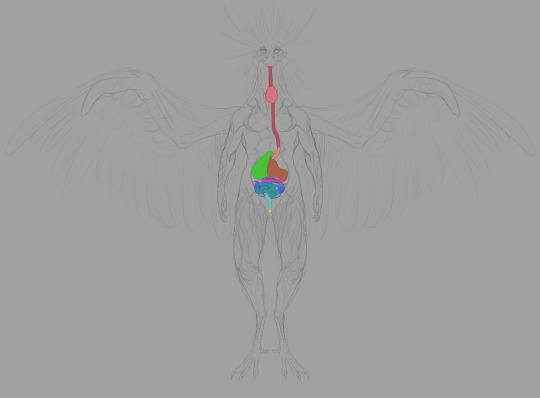

The esophagus is self-explanatory. Food goes in through the beak, traveling into the body through the esophagus.
The crop is used to store food: this is where digestion begins. Many parents regurgitate mushy, enzymatic food for their children from the crop. Very nutritious and promotes growth.
The proventriculus is the first half of the stomach: protein bonds begin to break down here. Gastric fluid produced here aids the gizzard in mushing things.
The gizzard is where the bulk of food-crushing occurs. Breaks larger matter down through transfer between areas within the organ.
The liver and gallbladder are crucial in digesting fats. Real bird livers have two lobes: the left is smaller than the right. Two bile ducts from the liver connect to the distal duodenum: the right duct is connected to the gallbladder. Chozo only need one.
The duodenum is the start of the small intestine, running in tandem with the pancreas. Pancreatic enzymes created by the latter assist in completing digestion, processing sugars, etc.
Digestion is finished in the other sections of the small intestine, where nutrients are absorbed.
Chozo kidneys largely resemble their human counterparts. Connected to the lower half of the gastrointestinal system. Urate is disposed of through the cloaca, transferred from point A to point B by the thin ureters bridging the kidneys to the large intestine.
Bacterial fermentation in the ceca extracts nutrients from plant material that can't be digested through enzymatic breakdown. The ceca and large intestine also reabsorb moisture, forming the solid portion of indigestible waste. The ceca are larger in tribes that eat more fruit and other plant products. Mawkin ceca are fairly small: they live quite an active lifestyle, and plant matter supplements their all-rounder diet with meat as the foremost staple.
The large intestine is the end of the line. Renal and intestinal waste is ejected here. The end of the reproductive tract forks to the distal segment to facilitate egg laying. Mammals have considerably larger large intestines than Chozo to dry out waste before expulsion.

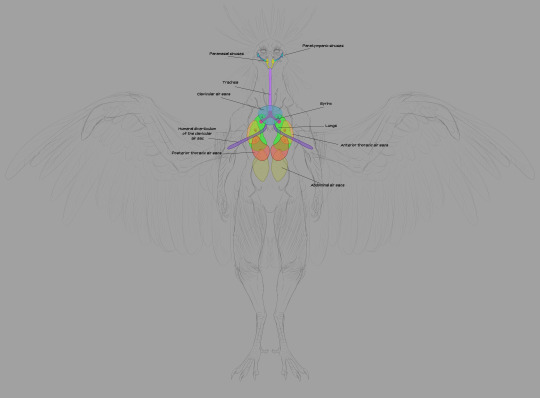
Next we have the respiratory system. The trachea takes in air and delivers it to the lungs. Unlike mammalian lungs, Chozo lungs are inelastic: they don't expand and contract. The air sacs do all the expanding and contracting: they're connected to the lungs through a network of bronchii.
The high metabolic rate required for flight demands a ton of oxygen, and Chozo respiratory organs are designed to do just that. The mechanics are fascinating but I won't take up too much of your time explaining the finer points. Wikipedia's write-up on the circulatory system of birds is a good place to start if you want to dive deeper.
The short version is thus: air enters through the nostrils, traveling into the bronchi through the trachea and syrinx (the syrinx helps Chozo vocalize). The bronchi deliver air to the lungs. When Chozo inhale, the posterior and anterior sacs expand: the posterior sacs take in fresh air while the anterior sacs fill with air that has already passed through the lungs. Air is constantly circulating through the lungs, and it's a one-way flow.
Parabronchii are microscopic tubes that run perpendicular to the blood capillaries. Parabronchii efficiently diffuse oxygen from the air into the blood.

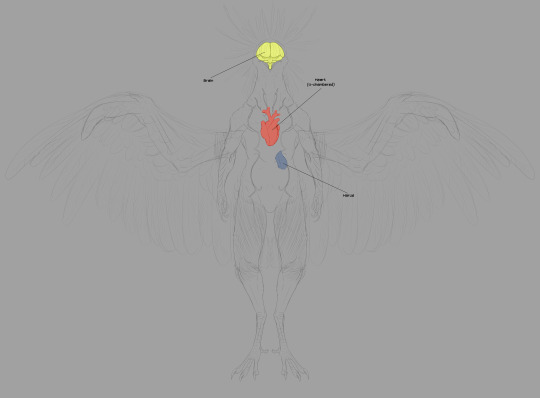
The next image set deals with a few extraneous vital organs. I'm not going to illustrate the nervous system nor arterial network, just as I neglected to illustrate all the bronchi in the respiratory system. That's a lot of tubes!
The circulatory system is pretty standard, but it pulls largely from Dread. Here's the thing: in the pre-boss fight cutscene for Raven Beak (aptly named 0086_comanderorbital_video_artwork_01.webm in the files), we see him contributing to Samus' biological makeup. His heart is set firmly in the center of his chest.
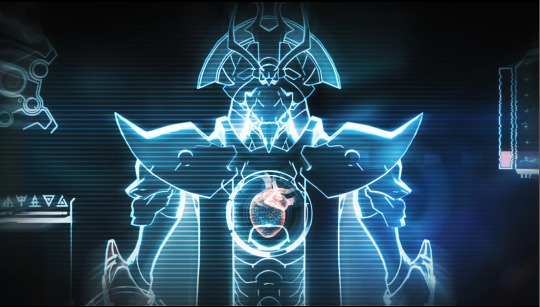
This is anatomically accurate to real birds! Bird hearts are placed similarly in the center of the chest, flanked by the left and right lobes of the liver (linked image is a labeled black and white illustration of a dissected pigeon, showing most of the major organs).
The brain is exactly what you think it is. No, the most interesting part of this last image set is the harus.
The harus is an accessory to the lymphatic system. You'll notice its proximity to the respiratory system. Lymphatic capillaries accompanying the parabronchi network filter more harmful atmospheric molecules into the harus, which makes use of specialized cells to recycle these molecules in a process that synthesizes ATP. In addition to this, the harus helps maintain the body's proper pH levels in hostile environments. This organ is what allows the Thoha to breathe in Zebes' toxic atmosphere.
Headcanon time: the majority of non-powersuit related genetic alteration done to Samus Aran in her youth is related to this organ: her respiratory system was altered with the proper instructions to produce specialized harus cells on their own without needing to transplant the organ. Samus can breathe on Zebes because her lungs can perform the function of the harus while she breathes.
Full-size pngs for everything are available on Ko-fi and Patreon. The canvas for this project was pretty big because I wanted to be able to capture the scale of the wings somewhat.
ADDENDUM, May 16, 2024: Chozo should have a modified pelvic bone that more closely resembles a synsacrum, not a humanoid ilium: I am a fool and completely forgot to make alterations in that department.
#headcanons#chozo anatomy#chozo#raven beak#metroid#metroid dread#metroid dread spoilers#gotta give props to friend of the blog Ivory who reminded me of ATP synthesis and suggested a second liver of sorts
53 notes
·
View notes
Text
Sibirionetta formozovi Zelenkov et al., 2023 (new species)

(Type coracoid [shoulder bone] of Sibirionetta formozovi [scale bar = 10 mm], from Zelenkov et al., 2023)
Meaning of name: formozovi = for Nikolay A. Formozov [Russian zoologist]
Age: Pleistocene (Gelasian)
Where found: Malye Goly, Irkutsk Oblast, Russia
How much is known: A nearly complete right coracoid (shoulder bone).
Notes: Sibirionetta is a genus of ducks including one extant species, the Baikal teal (S. formosa). S. formozovi was much smaller than the Baikal teal, being about the same size as extant pygmy geese (genus Nettapus).
Reference: Zelenkov, N., E. Palastrova, N. Martynovich, A. Klementiev, A. Sizov, and N. Volkova. 2023. A tiny duck (Sibirionetta formozovi sp. nov.), a giant grey partridge (Titanoperdix felixi gen. et sp. nov.), a new rail (Porzana payevskyi sp. nov.), and other birds from the Early Pleistocene of Baikalian Siberia. Biological Communications 68: 261–272. doi: 10.21638/spbu03.2023.406
40 notes
·
View notes
Note
One wing pet peeve of mine that I rarely see talked about: Wings sitting RIGHT above shoulders on four-legged creatures.
It drives me NUTS. Shitty doodle to illustrate my point.

Where do the bones go? The scapula and coracoid are intersecting? Are they just fused into one bone? How does the animal even move? Why not just move the wings back slightly where the bones will have more room???????
YOU ARE LITERALLY SO CORRECT THIS KILLS ME TOO FR FR
Give those wings some space im BEGGING like even if the bones clipping wasnt a problem everything else is like every single time those wings beat up and down theyre gonna drag the forelimbs with them that dragon's gonna be flying and clapping for its life
118 notes
·
View notes
Text
Round Three: Vorombe vs Annakacygna
Vorombe titan

Artwork by @otussketching, written by @zygodactylus
Name Meaning: Titan of the Big Birds
Time: 10,000 years ago to sometime in the past 2000 years (Holocene epoch of the Quaternary period)
Location: Southern Madagascar
Vorombe is a newly erected genus of Elephant Bird, the largest that we know of! Whereas all species of Elephant Bird used to be put in the same genus, distinct differences among the types of Elephant Bird that we know of indicate they deserve their own genus names - and here we are! Vorombe was significantly larger than the other species of Elephant Bird, and probably was about 3 meters (nearly 10 feet) tall when standing. It was also ridiculously heavy, weighing around 650 kilograms. As such, Vorombe is currently the largest known bird ever recorded. It lived in the arid and succulent woodlands as well as the grassland mosaics, the weirdly unique habitats that charactierize Madagascar, and was a major feature in the functioning of those ecosystem - helping to spread plant seeds and maintain habitats as they lived within them. Vorombe and other Elephant Birds lived alongside a lot of weird animals during the Quaternary of Madadgascar, including dwarf hippos, giant tortoises, and giant lemurs.
Note: A paper came out literally on the last day of February this year indicating Vorombe may not be its own genus. More work is needed to determine if this bird is distinct from Aepyornis.
Annakacygna hajimei, A. yoshiiensis

Artwork by @otussketching, written by @zygodactylus
Name Meaning: Swan from Annaka (Hajime’s or of Yoshii-machi)
Time: 11.5 million years ago (Tortonian stage of the Miocene epoch, Neogene period)
Location: Haraichi Formation, Annaka, Japan
Annakacygna was dubbed during its research “the ultimate bird”, and honestly, I don’t even blame the scientists for doing so - I may have even done the same. Both large species of swan, A. hajimei was about the size of a black swan, and A. yoshiiensis was larger than even the mute swan. They were weird in so many ways it boggles the mind: they were adapted for filter feeding in the water, their wings and tails were so flexible they could form a cradle for their young on their backs like modern mute swangs, said tails and wings were probably great and flashy display structures, its head was extremely large weird looking and had a slightly spoon-like bill, they had wide and heavy vertebrae but still had long and flexible necks, it may have even been a flightless bird or at least a poor flier based on its sternum and coracoids, though its scapula is extremely strong and unlike flightless animals - more research is needed to better understand this aspect of its mobility. That said, it did have very short wing birds, weirdly curved and short among birds, with weirdly shaped finger bones coming together to create weirdly formed curved wings. Its hips were arched up, creating a dip in its back, and it had narrow leg bones, allowing for efficient movement in the water like living *grebes and loons*. So while it had this whole weird display structure with its wings and tail going on, and its robust but long neck, and that strangely boat-shaped body (what the actual f-), it was zooming through the water like a grebe or loon. It had a similar beak to living shovelers, possibly, and it could move its jaw back and forth in a seesaw like motion, not like any living swans. It could then filter food through its jaws via this motion, eating a variety of plankton through soft lamellae within its bill. It was probably very social, given its display structures, and communicated both vocally (imagine the power of those calls with that robust neck) and visually. Annakacygna also took care of its young, extensively, keeping them on their back protected in their wings, to the point that they may not have spent much time on land (like living loons and grebes). It wasn’t a deep diver, but was stable at sea while foraging on food and moving along the surface of the water, living primarily in the ocean. Found in a marine environment, Annakacygna lived with sharks, seals, many kinds of whales, and desmostylians.
#dmm#dmm rising stars#dinosaur march madness#dinosaurs#birds#paleontology#birblr#palaeoblr#bracket#march madness#polls#vorombe#annakacygna#round three
145 notes
·
View notes
Text
Wings


Imagine Manwë getting off of you simply rubbing and groping his wings, making him cum without doing anything else. The way whines fall from those pretty lips of his when you nip softly at them, the way you can see how his cock begins throbbing as you place featherlight touches on his great wings. You're driving him insane.
Pairing: Manwë/GN!Reader
Themes: SMUT
Fic type: Imagine
Warnings: Cum, drooling, wing kink. ( Tell me if there are more. )
Rating: sweet chili chocolate | MDNI | 18+

"Dove-"
The whine that falls from Manwë's lips is so pretty, full of nothing but intense pleasure and desire, your touches rendering him speechless.
And oh how his lust-filled groans and indecent loud moans, that would have most on their knees, flow throughout the room freely so shamelessly and so beautifully, leaving you sopping wet as you continue to tease and grope at the softness of his great wings.
A specific stroke of your hand against the coracoid bone has the king breathless and trembling, struggling to keep himself still.
More groans rumble deep within his throat as you tug at the insides of his sensitive wings, softly pulling at feathers and teasing the top bones with small licks and nips.
"Dove, let me touch-"
Your hand gives him a firm squeeze, drawing another loud, hoarse moan from him, while watching the drool trickles down the corners of his mouth, dripping down onto his stomach.
With your gaze focused on the large throbbing cock in front of you, a soft and warm hand moves to the top of his left wing, only to lightly and agonizingly slowly, drag it down towards the tips of his feathers and the end of his wing.
A pearl of cum forms at his tip, resulting in a smirk tugging at your lips.
Tongue against teeth, you slip it through your mouth to wet your lips and gently bite down on the top of his wing, eyes remaining on the flushed tip below you.
Time stops for Manwë and he can't even feel himself anymore. Strings of cum shoot out of his large member, and all just from your blissful touches against his wings...
It's embarrassing and arousing at the same time, that you have this much power over him by just a few light touches on his wings.
He'll get back at you eventually though, and he won't be showing any mercy.

Don't forget to leave a like and reblog my content if you enjoy it!!
Enjoyed my imagine and wanna read more fics, drabbles, etc?
Put yourself on the taglist dear!
Taglist: @edensrose @everstarlight
A/N: This thought came to me, and I knew I had to make it HHHHHHH.

#˚₊‧꒰ა ☆ ໒꒱ ‧₊˚|| Howell's cottage || - ⊹˚. ☼#Silm smut#Smut#MDNI#Manwë Súlimo#This for errbody going through their first wing kink phase. Believe me been there. Done that#But everyday above ground is a great day- Dale oæIHEWDFJSNÆLIOUJHN#Manwe sulimo#the silmarillion#Manwë/GN!reader#x gn reader#gn reader#gender neutral reader#x reader
51 notes
·
View notes
Text
Wish Upon a Fallen Star
I'm still on the waitlist for AO3, so I thought I'd just post the first part of this fic on here. I haven't written fiction for a long ass time, 20 years maybe? I've got so many ideas rolling round in my head, feels good. Just a short one to start though. 906 words. This will be in 2 parts and should post the rest this weekend. Feedback welcomed but please be gentle if possible!
---
A loud crack pushed him to spin on his heels. The heat from his sword flickered near his face as he moved. Aziraphale looked up at the brooding sky, shades of purple betraying the chaos of the battlefield below. In this liminal dimension, chunks of stony island floated among fractured celestial architecture. Everywhere around him the battle still raged. How long had they been fighting? It felt like days had passed since the two sides had first clashed.
He felt a deep ache in his bones as weariness overtook him.
“Why are we tearing ourselves apart like this!” he shouted, then bit his lip as he thought better of the question.
He spotted a star, brighter than those peeking through the background; it shifted, slowly at first. The light streaked downwards, gathering speed. “That’s no star,” Aziraphale whispered to himself. Following the movement of the falling star with his eyes, he made a wish [1].
[1] It was perhaps the first wish made upon a star, and much later it would be he who put the idea into a human’s head. After all, his wish had come true, surely it would work for them too.
His wings beat once, lifting him from the broken ground. His muscles tensed and he propelled himself forward. As he approached his doubts grew. Sparks fizzed around the light, flying off into the dark before petering out. There! He inhaled sharply as he saw the outline of pale feathers shimmering in the burning blue-white light. His strong wings beat faster now, matched by his heart hammering against his ribcage. Could it be them? He’d looked everywhere, scouring every corner of the battlefield, searching for one angel.
“No!” his voice was thin, his throat tightening as he spotted strands of blazing copper hair plunging through the heavy air. He could make out the singed robes fluttering around their limp form. His eyes filled with determination, although the lines on his face betrayed the fear that gripped him. He dived.
So cold. So bright. I can’t feel my wings. I can’t feel. I can’t.
A wide island rushed towards them. Too fast. I have to make it, thought Aziraphale. I have to. Please God help me. His wings burned with the effort as he caught up to the trail of light. His face stung as the ash and sulphur in the air whipped at him. Tears sprung unbidden from his wild eyes as his jaw opened in a scream of terror. He reached with both arms, dropping his sword as his fingertips grazed the hem of the angel’s smouldering robes. And then there was no more sky.
Dark. Thunder. I can’t feel Her.
A cloud of dust and bits of grass blew across the platform, the impact shuddering through the grey stone. The dust slowly settled on a jumbled pile of feathers. Stillness fell as gently as the night, the sounds of fighting suddenly distant.
One of the wings twitched.
Soft. So soft. Softsoftsoftsoftsoft sosososo…
Aziraphale opened his eyes. They were sticky with tears and the ash clinging to his lashes. He held his breath as he moved his wings, sharp pain spreading through the shoulder under him to his coracoid. Taking a ragged breath to push the pain to the back of his mind, he dared himself to look in the space between his arms.
The angel’s shock of red hair spilled across Aziraphale’s chest, just below his chin. Their limp form seemed too small as he held them tightly. Relief flooded through him and his breath hitched, slowly morphing into small sobs as more tears streaked down the sides of his round cheeks. He rolled onto his back, cradling his fallen star gently and burying his face in the long fiery tresses.
“Please,” he whispered longingly, “please. Please wake up. Please wake up. Don’t go. Please this can’t be the end. I’m sorry I couldn’t find you. I promised I would.. I’m sorry, I’m so sorry..” he broke off with a tight feeling in his throat and cold dread gripping his stomach.
Softsoftsoftsososoft I don’t want to go
The angel breathed in suddenly and coughed twice before the sound dragged out into a whine. Aziraphale’s eyes fluttered closed.
“Oh thank God! Oh, thank you thank you,” his mind raced as words tumbled out of him “It’s alright, I’ve got you, I’ve got you. You’re ok, you’re alright, I’ll never ever leave your side. I’m here, I’m here, I'm right here dearest”. He smoothed his hands gently over the angel’s back, feeling their breathing slow as they came to.
“Azi.. Azi…” they croaked, pressing their face to his chest. Aziraphale felt the hands that had created so many of the Universe’s beauties bunch in the fabric around his waist. “Azira…”
“Raphael,” he replied in a soothing voice “my darling, it’s me. You’re going to be alright now my dear. Just stay still a moment, you’ve been through the proverbial wars I fear.” They lay there on the grass in the middle of the empty sky, far below the celestial combat they had plummeted through. Time seemed to stretch out and Aziraphale thought he could well stay there for all Eternity and be happy with his lot.
I want to stay. Here forever. For Eternity. Please don’t let this moment end. It’s all going wrong, please just let me stay. Here here just here with him please please please just him just here…
---
to be continued shortly...
#good omens#ineffable husbands#good omens fanfiction#good omens fic#good omens fanfic#angel!crowley#pre fall crowley#aziraphale#angst#hurt!crowley#The Great War#Just a short fic#celestial being#I had so much fun writing this#good omens 2#michael sheen#aziraphale pov#SFW fanfic#good omens fandom#my writing#first fanfic#in a long time anyway#ficlet#aziracrow#aziraphale x crowley#raphael!crowley
34 notes
·
View notes
Text
Tapinocaninus

Tapinocaninus was a genus of tapinocephalid therapsid from the Middle Permian. Its type and only species is T. pamelae. Its known specimens were found in the Karoo Supergroup in South Africa. Tapinocaninus is the largest known therapsid from the Guadalupian Period.
The generic name Tapinocaninus means humble (tapino) canine (caninus). The specific name pamelae was named for Pam Rubridge, the mother of the original describer, Bruce S. Rubridge. She was on the field when he discovered the first fossils.
Most known Tapinocaninus fossils consist of skulls, though its spine of 36 vertebrae, several ribs, pectoral and pelvic girdles, three humeri, and a femur have been discovered. Its autapomorphies include a relatively large temporal opening, only having two sacral vertebrae, only seven caudal vertebrae, a notably high amount of vertebral intercentra, an anterior coracoid included in the glenoid, which is straight and facing posteroventrally, and the lack of ectepicondylar foramen.
Tapinocaninus has been recovered as the most basal member of Tapinocephalidae, as it has both derived dinocephalian features and ancestral features of sphenacodonts. Tapinocephalidae itself is the most derived family of Dinocephalia.
Original paper: Rubridge 1991, Postcranial materials description 2019
Wikipedia article: here
#tapinocaninus#tapinocanininae#tapinocephalidae#dinocephalia#therapsida#therapsids#paleoart#paleontology#original art#human artist#artwork#obscure fossil animals#obscure fossil therapsids
10 notes
·
View notes
Text

👽 Trying Human has updated! tryinghuman.com
📕 Buy the books here: tryinghuman.storenvy.com
🌳 Linktree: linktr.ee/tryinghuman
#trying human#tryinghuman#webcomic#graphicnovel#comic#update#alien#ufology#ufologycomic#reptoid#reptilianalien#magnus#longus#coracoid
27 notes
·
View notes
Text

How sweet the sound of severance;
Deep is the gouge of your flesh.
You howl the scream of a child unborn,
the gnarled hand of an empty womb
reached up to take you back.
What is an angel with no wings,
if not a man who screams for mercy at the sky?
The cradle of your mouth once a home for my praise,
the curse of your tongue now the bite of a knife.
Bleed the grief from my veins, my love;
paint the hollows of your ribs with my tears.
Make for yourself a home in which your father weeps,
O, Architect.
From the rot of my bones,
and the leather of my flesh,
build for yourself a cage of unexpressed torment.
Fathers are only fathers
when they break that which has been bestowed;
Know, if nothing else, that you are my son,
for the ivory jut of your coracoid bone,
is at once a knife a spear a stone.
How soft the bed in which I lay;
far above where you now rest.
Downy feathers from the wings I plucked,
under my cheek, a soft caress.
Heady is the taste of devotion,
the grit of Adam's rib on my tongue,
You played the part of the wanderer, boy,
now look at all the grief you've won.
Carved from me is the nucleus of you,
an entwining that shall never be undone;
When you look at the heavens,
you see a love unraveled,
But when I look at the earth,
I see only my son.
Wail the song of the damned, my love;
Hell hath become the Sinner's stage.
Sing your anguish to the fabrics of the sky,
until all of Holy Heaven tastes your rage.
One day, you will find your place again,
and on your knees will you beg.
A boy returned home
with pockmark scars
ready to have his feathers plucked again.
the death of the firstborn (exodus 11) {for @malinaa} // j.s.
#Um. Holy shit.#my writing#poem#poetry#religious imagery#mine#spilled ink#au where god feels bad about kicking satan out of heaven???#lol. holy shit#anyways i saw this pic and thought you might like this#mwah <3#theologically incorrect christianity (hehe)#christianity#yes i know one line is not italicized. tell tumblr that.
97 notes
·
View notes
Text

The aba, sometimes spelled abba (take a chance) or simply called a birdie straight jacket, is a very old falconry tool designed to keep a raptor’s wings (and sometimes legs as seen with this aba) still. In ancient falconry this was used to keep a bird from leaping from glove or perch as it prevents wing extension and thus removes their instinct to take step two of the sequence to initiate flight. This is not an effective strategy in training outside of learned helplessness and is now seen as outdated.
Instead, it is now used most often by rehabs and vets that specialize in raptors in order to keep patients from bashing and damaging wings in kennels or stabilizing a coracoid fracture. It is occasionally seen in use by falconers for when a bird is injured and needs a quick exam, or by bird banders though they tend to favor the variant which includes a cloth head cover or simply add a hood in conjunction with the aba.
Though in general bird banders tend to favor the trusty can to restrain raptors.

And I would too as it’s very funny.
135 notes
·
View notes
Text
Enantiornithean Earth
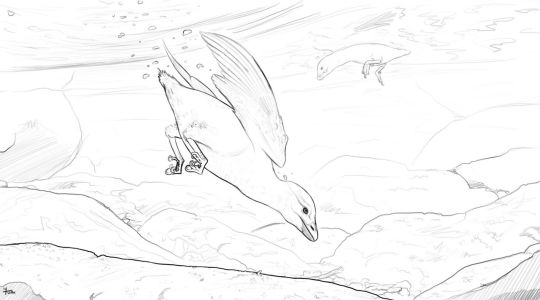

Yungavolucris and Halimornis by midiaou and xenopleurodon respectively. Both are real life Cretaceous taxa, showing that these birds were already diversifying into aquatic ecologies.
Enantiornithes are a group of extinct flying theropod dinosaurs that you could reasonably call birds, being the sister group of Euornithes (the group that includes modern birds). However, they differ from our birds in a variety of ways (their name literally means “opposite birds” for a reason):
Several skeletal details, including a tarsometatarsus that is either unfused or half-fused (beginning at the top rather than at the bottom, the opposite than in modern birds), an articulation of the scapula and coracoid that is oppositely shaped (hence the name; the coracoid joint is convex and the scapula joint is concave shaped in enantiornitheans, while the opposite happens in modern birds), a shallower sternum keel with bizarre antler-like projections (which, combined with large crests in their humerus, suggests the muscles lifting the wing were attached to the back as in bats and pterosaurs, rather than all flight muscles being attached to the keel as in modern birds), and a large, rod-shaped pygostyle (which will be relevant later).
Usually toothed jaws instead of beaks, though some taxa did become toothless. Even then, these weren’t capable of cranial kinesis like modern birds (i.e. watch a duck or your pet parrot yawn and you can see them moving their upper jaw; enantiornitheanss are many things but they’re not that abominatory).
All known taxa thus far seem to have been superprecocial: ample sites show buried eggs like those of megapodes, and the hatchlings were already fully flight capable soon after birth.
Unlike modern birds, enantiornitheans lacked a tail fan. They either had contour feathers on their butt like in the rest of the body or had long, streamer-like display feathers, also found in other Cretaceous bird groups but not in modern birds. Some species did have retrices, but they were arranged along the rod-like pygostyle and were not a movable fan, so essentially they were a variation of the tail fronds seen in Archaeopteryx and kin. Note that this did not make flight harder; even modern birds can fly reasonably well without a tail.
Why the opposite birds died out at the end of the Mesozoic while ours survived is unclear. Often, a bias towards arboreal niches is cited, as many enantiornitheans were in fact arboreal, but as the examples above show they also occured in marine and terrestrial niches alongside the ancestors of modern birds. Another possibility is their supreprecocial habits, meaning a more complex ecology as the birds matured since they were already functionally independent since birth, and this did hinder reptiles like lizards so the answer might lay there.
Or, most likely, it was just dumb luck.
Anyways:

Senmuruy hvare by Dave García. A four meter wingspan predator vaguely analogous to the golden eagle and cinnereous vulture, soaring across the northern hemisphere for corpses to dig its long snout into or live mammals and birds to sink its talons into.
Many Cretaceous enantiornitheans were already suspected of being raptorial, so it is only natural that, once pterosaurs were gone, they’d increase in size. Some reach wingspans of fiver meters, but most are more moderately sized at 1.5-3 meter adult wingspans. Smaller sizes are handled by the young, which like all enantiornithes can already fly since birth and occupy distinct ecological niches. Most species protect the nest and moderate its temperature like our megapodes, and a few even display mild parental care, allowing the young to remain in the vicinity until they’re large enough to be competition.

Euodontopteryx anatosuchus, a six-meter wingspan pelagic soarer that occurs in tropical and temperate waters, using its massive wings to ride on thermals like frigatebirds while landing to feed like albatrosses. Males sport streamer-like display feathers. By Dave García.
As noted above, some Cretaceous enantiornitheans were already aquatic, so this trend continued. Some species became divers, mostly wing propelled and some even flightless like our penguins, while others inversely invested in supreme gliding abilities, able to either ride thermals like frigatebirds or wave winds like albatrosses.
The most impressive species are reccord beaters. Divers can be as tall as a man when on land, while soarers can reach wingspans of over 7 meters, competing with flying multituberculates for largest living flying animals. Both groups tend to have long, toothy maws, the teeth alloted into a single row rather than individual sockets; this condition is known in both extinct sea birds and reptiles as well as some living cetaceans, and is known as aulacodonty.
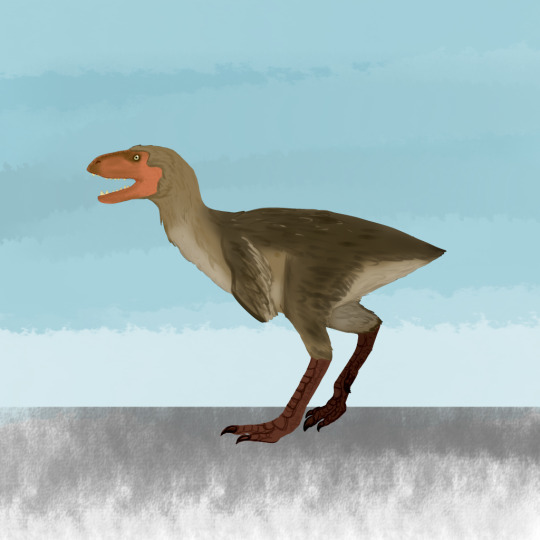
Ghaltavis rex, a three meter tall predator that stalks African and Asian savannas. An apex predator of its own right, an echo of the distant unrelated tyrannosaurs in the form of a bird. By Dave García.
At least one real life enantiornithean, Elsornis, appears to have been flightless. It’s descendents were quick to occupy roles previously taken by non-avian theropods, from ratite-like herbivores to formidable predators that look like the fusion of a terror bird and a tyrannosaur, using their powerful jaws to crush bone.
The relatively long enantiornithean pygostyle allowed them to balance their pelvis/femur joints (a known size inhibittor in our birds) and grow to sizes larger than our timeline’s birds, though species above a ton are fairly rare seeing as mammals got their footing as well.
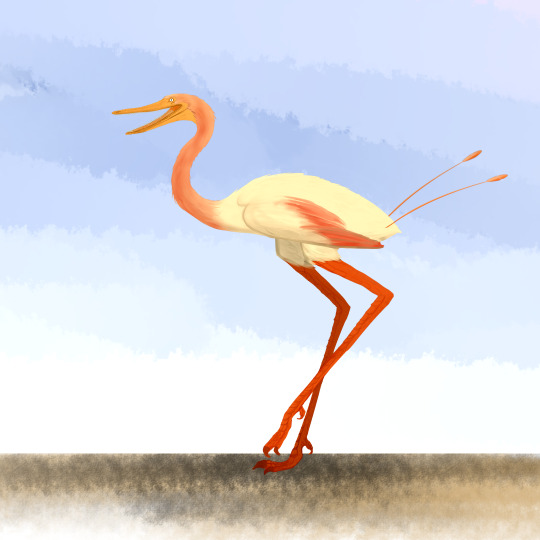
Bennu seti, a filter-feeding bird from Africa, Eurasia and Australia. Like flamingos it metabolizes carotenoids, giving it an orange colouration. By Dave García.
The Cretaceous Lectavis had long legs in some aspects convergent with those of flamingos. Thus, several enantiornitheans developed wading ecologies, ironically more associated with their euornithean competitors. Some became probers, dipping their maws (or toothless beaks) into the subtrate, while others became piscivores like herons or aquatic plant specialists like some cranes and magpie geese.
Most spectacular is a filter-feeding clade, Bennuidae. These birds modified their teeth into thin, delicate strands like some Cretaceous pterosaurs, and feed by swallowing water and expelling it, trapping prey in the teeth and keratinous spikes in the tongue. Having the nostrils still at the end of the snout, these birds usually feed in a different position from flamingos: rather than upside down, the lower jaw is submerged, in a manner similar to avocets.
Like most opposite birds the young are superprecocial, starting as plover-like birds before transitioning into a filter feeding lifestyle months later. Though some taxa form protective creches like flamingos, though unlike them they do not feed the young.
Like many of our shorebirds, these are continuous flappers, displaying remarkable endurance as they fly non-top for days in their migrations.
#enantiornithes#enantiornithean#enatiornithine#bird#birds#dinosaur#dinosaurs#paleoblr#palaeoblr#speculative zoology#speculative evolution#speculative biology#spec evo
26 notes
·
View notes








